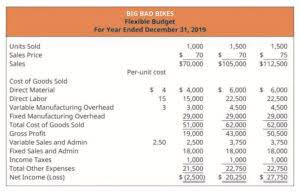
We will look at what liabilities are, their categories and examples, and compare them to assets and expenses. The debt ratio shows the percentage of a company’s assets financed through liabilities. Now, after understanding how to calculate liabilities, the next step is to explore the financial ratios that use these figures to evaluate a company’s debt management and overall economic health. Understanding liabilities becomes much easier when viewed through a real-world lens.
Liability Accounts
In a sense, a liability is a creditor’s claim on a company’ assets. In other words, the creditor has the right to confiscate assets from a company if the company doesn’t pay it debts. Most state laws also allow creditors the ability to force debtors to sell assets in order to raise enough cash to pay https://heizhaus-gebesee.de/wordpress/?p=1472 off their debts. Also known as unearned revenue, this is money you’ve received before delivering the goods or services.

Current
For instance, if a company is facing a lawsuit with a probable and estimable loss, it must disclose this information to provide a complete picture of potential financial risks. Understanding contingent liabilities is vital for assessing the uncertainties that could affect a company’s financial position. In the realm of accounting and financial reporting, liabilities play a crucial role in understanding an organization’s financial health. They represent obligations that a company must settle over time, often impacting both short-term operations and long-term strategic planning. Understanding how liabilities affect key financial ratios like debt-to-equity ratio and current ratio provides valuable insight into a company’s ability to meet its financial obligations.
Financial Consolidation & Reporting
- Contingent liabilities are potential future obligations arising from specific events or outcomes, disclosed in the financial statement notes but not recognised as actual liabilities.
- As businesses continuously engage in various operations, their liability position can change frequently.
- The assets of an individual or an organisation will be resources such as cash, property, or gear.
- Examples of contingent liabilities include warranty liabilities and lawsuit liabilities.
- To calculate, non-current liabilities, add up deferred tax payments, and long-term loans.
- A larger company likely incurs a wider variety of debts while a smaller business has fewer liabilities.
- The amount of short-term debt— compared to long-term debt—is important when analyzing a company’s financial health.
These ratios help investors, creditors, and analysts evaluate a firm’s liquidity, solvency, and overall financial health. Lastly, unamortized investment tax credits (UITC) represent the difference between the taxable cost of an asset and the amount that has already been deducted as a tax benefit over time. These liabilities can impact a company’s financial statements significantly by altering its net income and cash flows. One common type of long-term liability is long-term debt, also known as bonds payable. Companies issue bonds as a form of borrowed capital that must be paid back with interest over an extended period.

Understanding Liabilities in Accounting

They are classified liabilities in accounting as current liabilities (due within a year) or non-current liabilities (long-term obligations not due soon). In a business scenario, a liability is an obligation payable to a third party. It may or may not be a legal obligation and arises from transactions and events that occurred in the past.


Each classification on the balance sheet plays a distinct role in financial analysis. Current liabilities are crucial for liquidity analysis, while non-current liabilities are significant for understanding a company’s long-term financial stability. Together, these classifications contribute to a comprehensive picture of a company’s overall financial health, influencing decisions related to investment, lending, and business operations.
- The not fair value adjusts it’s for the cost of acquisition, costs such as accounting or administrative cost.
- When a company deposits cash with a bank, the bank records a liability on its balance sheet, representing the obligation to repay the depositor, usually on demand.
- We have helped accounting teams from around the globe with month-end closing, reconciliations, journal entry management, intercompany accounting, and financial reporting.
- This recognition is crucial as it ensures that all financial obligations are recorded in a timely manner, providing a transparent view of the company’s financial health.
- These are due for settlement in more than one year, and almost always involve long-term borrowings.
Liabilities and Business Operations
A debit either increases an asset or decreases a liability; a credit either decreases an asset or increases a liability. According to the principle of double-entry, every financial transaction corresponds to both a debit and a credit. In short, there is a diversity of treatment for the debit side of liability recording transactions accounting. Here’s why liabilities matter and how they impact the day-to-day and long-term outlook of any business.

